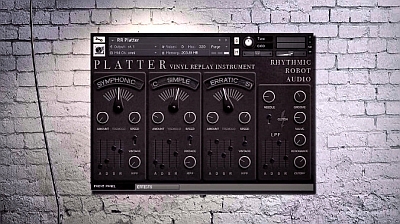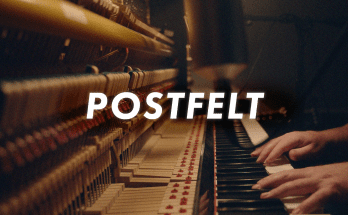A unique time- warped optigan / string hybrid !
“Perhaps this is the strangest instrument RR … for lovers of strange and dusty, it is simply necessary»
Computer the Music Magazine
Trehostsillyatorny synthesizer based on vinyl with variable waveforms 1960s or 1910s, and 35 preset patches • Adjustable needle drop sounds and background crackles for authenticity at 78 rpm. • Remember the aura of Birotron, Optigan and other playback instruments from the Mellotron era.
Perhaps our roughest and most uncouth instrument to date, the Platter is a hybrid of a string synthesizer, taking as its starting point a variety of synthesizer waveforms but reimagining them as built into a vinyl-based reproducing machine. If Solina and Optigan had been left in the attic for fifty years and had children, it might sound like this …
The basic premise is pretty simple: we took a lot of synthesized waveforms, but with a big bias towards the synth end of the spectrum, and applied them to dubplates in our local vinyl studio. We deliberately did not go the standard saw, sine, square route for this; instead there are a couple of “basic synths” as well as a set of more orchestral sounds taken from older string synthesizers and other more complex instruments. So instead of choosing Pulse or Saw, you have things like Symphonic, Baroque, Choral, and Elegiac. Not sure how it will sound? Try it and see ?
We then reproduced these vinyl waves on two vintage machines: a 1960s Dansette and a 1910 portable 78 with a steel needle and built-in horn. The result of this process is two completely different sets of waves, one more or less consistent with the original sounds (but with a little crackle and wobble), and the other a tightly band-limited, all-vintage tone that sings merrily. whenever you hit the Vintage Oscillator switch.
The interface is where you take these starting points to the next level. You have three oscillators to play and mix, each freely selectable between a 60s wave and a vintage version. Each wave has its own amp envelope and tremolo control (which can be set super slow to fade in and out almost subconsciously), as well as a very useful high-pass filter. Turn it up and you have hiss and crackles, which can be a great way to add a bit of vintage character to a tone that’s mostly two 60s-era tones.
At the right end is a block that links all three oscillators together using a common filter circuit (complete with an envelope), a tube saturator to boost the sound, and dual Needle and Groove controls. The needle controls the initial stroke of the needle and simulates the engaging of the plates with each key press. A groove is a continuous, looping crackling sound at 78 rpm, sampled from a 1910 turntable and played while you hold a note. Judicious use of these two controls can really help mimic the behavior of an aging Optigan-style car. Plus, of course, there is the Glitch control for instantly generating random patches (with a bias towards musically useful patches). Click on it and get new inspiration immediately!
On the back are echo, reverb and rotary speaker simulators, as well as a simulated cockpit, which can very quickly and easily channel sound into useful new directions.
Obviously, Platter is not entertainment: it is completely original and intentionally unusual instrument. It stands out for vintage soundscapes, black and white horror movie soundtracks, sullen steampunk waves, background music for cruising the turn of the century on the rivers of Cambridge with Victrola playing in the bow … if you will. Travel in your tracks to another era. Platter plays well with other sounds too: try layering it with your chosen patch, then adjust the HPF so it doesn’t compete, and let it add a vintage vinyl airiness to any tone you like. Combined or solo, this is what you need if you want a nostalgic sepia filter on your lens!




